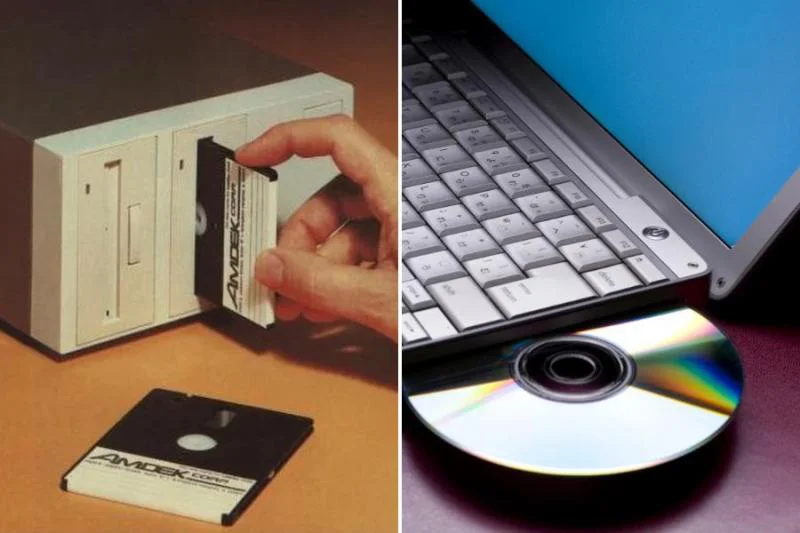The main difference between a diskette (also called a “floppy disk”) and a compact disc (CD) is how much data they can hold, how they look, and how they store and get data. Diskettes are magnetic storage media that can hold between 720 kilobytes and 1.44 megabytes of data. They have a thin, flexible magnetic disc inside a square case made of plastic. Compact discs are optical storage media that can hold up to 700 megabytes of data. They are made of a thin, circular disc of polycarbonate covered with a thin layer of metal. CDs use a reflective surface and a laser to read or write data.
What is a Diskette?
A diskette, also called a “floppy disk,” is a type of magnetic storage media used to store and move data between computers. From the 1970s to the 1990s, diskettes were very popular, especially for personal computers. They were also essential to the growth of the software industry and data storage.
Diskettes are made up of a thin, flexible magnetic disc that is put inside a square plastic case to keep it safe from dust and damage. Inside the floppy disk drive is a read/write head that interacts with the magnetic surface to store or get data. Data is stored on the magnetic disk in concentric tracks, which are then broken up into sectors.
There are different sizes of diskettes, but the most common is the 3.5-inch floppy disk, which can hold 1.44 megabytes. 5.25-inch and 8-inch diskettes, which were used in earlier versions, had smaller storage capacities.
With the rise of newer storage technologies like CDs, DVDs, USB drives, and the cloud, diskettes aren’t used as much as they used to be. But they are still an important part of the history of computers and a sign of early personal computers. Diskette drives are mostly used today for nostalgia, as collectors’ items, or in older systems that still need them to store or transfer data.
What is a Compact Disc?
A compact disc (CD) is an optical storage medium that stores and retrieves digital data, such as computer files, audio files, and videos. Since they were invented in the early 1980s, CDs have changed the way data is stored and shared. They have more storage space, last longer, and are easier to use than magnetic storage media like diskettes.
A CD is made up of a thin, circular piece of polycarbonate with a layer of metal that reflects light. A layer of clear lacquer protects this layer. The data is stored on the disc as a spiral track of microscopic pits and lands that move outward from the centre. A laser in the CD drive reads the data by shining light on the surface and noticing how the pits and lands change the way the light reflects.
The most common type of CD is the CD-ROM (Read-Only Memory), which can hold up to 700 megabytes and can only be read, not written on or erased. Other types include CD-R (Recordable), which lets users write data only once, and CD-RW (Rewritable), which allows users to write, erase, and rewrite data more than once.
Even though DVDs, Blu-ray discs, USB drives, and cloud storage have mostly replaced CDs as a storage medium, CDs are still used for a number of things, such as audio CDs, software distribution, and data archiving.
Difference Between Diskette and Compact Disc
When comparing a diskette (floppy disk) to a compact disc (CD), the most important distinctions are their storage capacities, physical structures, data storage and retrieval technologies, and levels of prevalent use in modern computers.
Storage Capacity
Diskettes’ storage capacity is low; it ranges from 720 kilobytes to 1.44 megabytes at most, while a normal CD-ROM can store up to 700 megabytes of data. The massive capacity disparity between the two partially drove the transition from diskettes to CDs for storing and sharing data.
Physical Structure
A diskette consists of a thin, bendable magnetic disk housed in a square plastic shell. A compact disc (CD) is a thin, circular, polycarbonate disc that has a reflective metallic layer and a clear lacquer covering to protect it. Diskette storage devices are square, while compact discs are spherical.
Storage Technology
Data on diskettes is stored magnetically in concentric tracks that are then broken up into sectors. Data is stored or retrieved from the disk drive’s magnetic surface via interaction with a read/write head inside the device. CDs employ optical storage technology, where data is written in the form of minute pits and landings on a reflecting surface and then read by a laser in the CD drive.
Prevalence
Due to its low storage capacity and the widespread adoption of more powerful storage technologies like CDs, DVDs, USB drives, and the cloud, diskettes have become obsolete in modern computing. Although being phased out in favour of newer technology, CDs are still utilised for things like music storage and data archiving.
In conclusion, the capacity, physical structure, and data storage technique of diskettes and CDs are the primary points of differentiation. Diskettes, with their magnetic storage and limited capacity, were popular in the early days of personal computing, but CDs, with their optical storage and bigger capacity, became the standard storage media, displacing diskettes in most applications.







